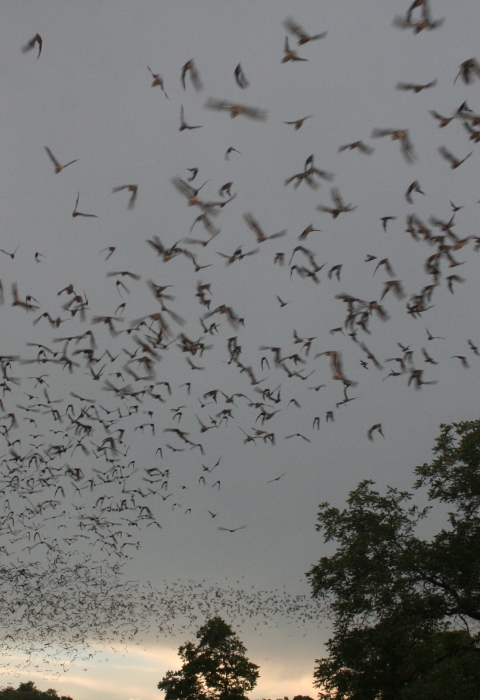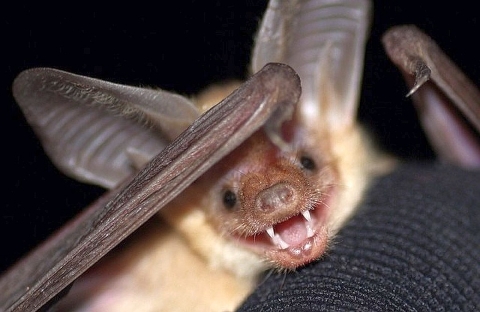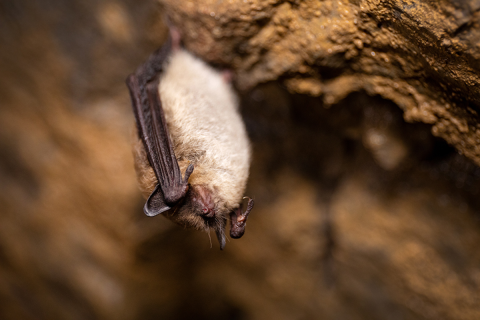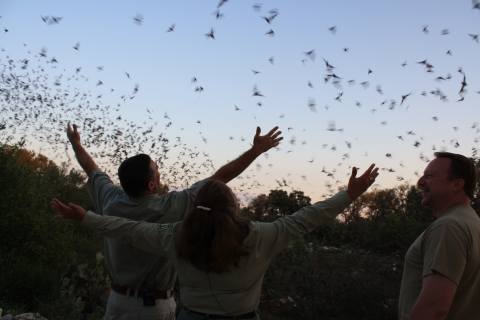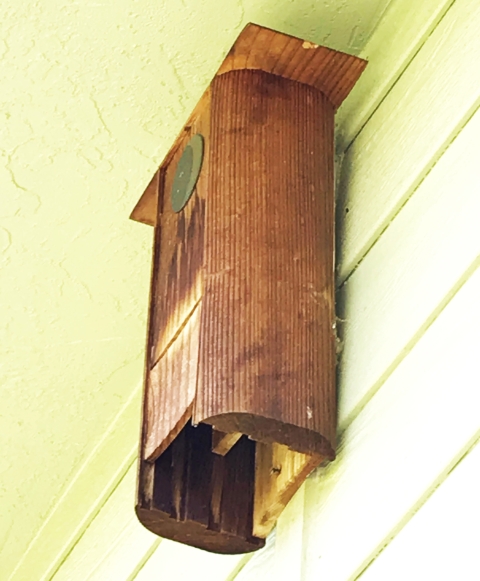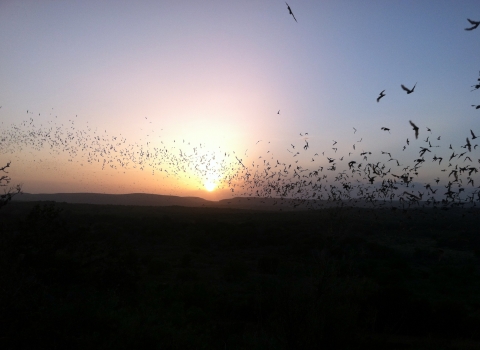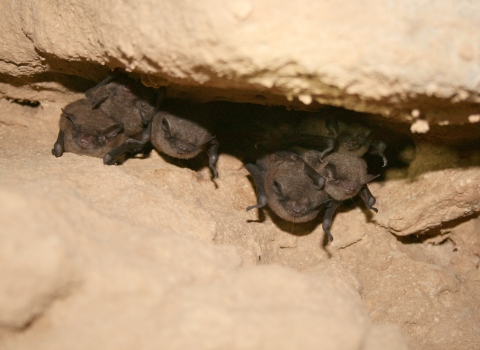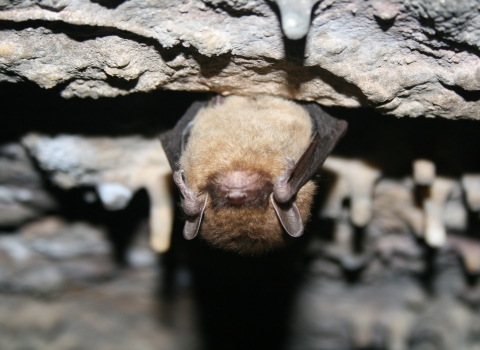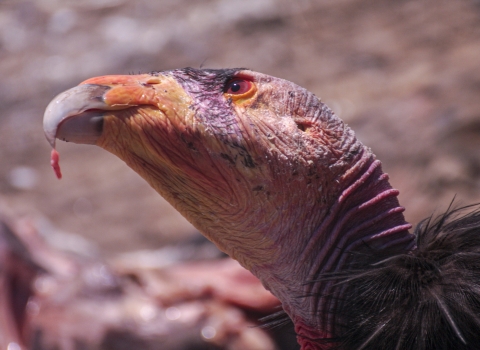On Halloween we are surrounded with images of bats – creatures of the night that evoke myths and stories based on society’s fear of the dark. In our family, we have a friendlier view - my daughter calls them nightbirds. In the evenings, we will watch for their stutter stop wing beats against the twilight sky. We celebrate each time we imagine they eat a mosquito. Hooray!
Here in the Pacific Northwest bats are an essential part of our ecosystems – in our backyards and throughout protected public lands. Though my family might call them nightbirds, bats are not birds at all. They are the only mammals that fly, giving birth to live babies that stay with their mothers for up to nine months. During that time, they learn to find food and take to the night sky like their mothers.. Most bats are insectivores – meaning they eat primarily insects. Bats are the top predator of night-flying insects. Moths, beetles, flies, mosquitoes – all are on the menu. In tropical regions, some species of bats also play a crucial role as pollinators – eating fruit and dispersing seeds, drinking nectar and pollinating flowers. There are also bats that eat small mammals and catch fish. And yes, there are even three species of bats that lap blood from wounds they create on other animals.
Learning how to identify bats has been a fun activity for our whole family. There are many things that can help you identify bats - what do their wing beats look like, what sounds do they make, and where you observe them. Once you learn how to look for bats, you’ll wonder how you never noticed them before! The best method for observing them is to sit quietly near a place with quality habitat and food resources…and wait.
Understanding which species are present in your area is an important part of being able to identify them. The bats in Idaho, Oregon, and Washington are insectivorous, helping control insect pest species that can damage crops and even act as a vector for diseases such as the West Nile virus. From coastal forests to rocky high elevation deserts and mountain ranges, the wide range of ecosystems means over 14 species of bats can be found across the Pacific Northwest.
Bats prefer quiet places to roost, or rest, during the daytime and hibernate during the winter. Some bats, such as little brown bats, like to congregate together in dark places such as barns and caves. Other species, such as hoary bats, prefer to rest on their own in trees. In general, you can find bats in your neighborhood and more wild places such as national wildlife refuges, forests, and open public and private lands.
Bats you might find near your neighborhood could include little brown bats, big brown bats, California myotis, and Yuma myotis. In more wild places, you can also find hoary bats, pallid bats, and even rare spotted bats. Since they all eat insects, look for them in places where insects gather – over the top and along the edges of bodies of water, grouped around streetlights, or over patches of native plants. If you look closely, you will see them darting and diving like airborne acrobats as they swoop through the sky catching insects, maneuvers that distinguish them from birds.
While it may be hard to see bats, it can be even harder to hear them. The sounds that bats emit are ultrasonic and beyond the range of human hearing. Bats use echolocation to navigate and hunt their prey. They emit sound waves that bounce off objects in the environment and return to the bats’ ears, allowing them to see a map of their surroundings even in the dark. As they key in on possible prey, the calls get faster and then swoop! Dinner time! The shape of a bat’s ear and their echolocation frequencies can suggest what prey they prefer. Small bats with smaller ears and a higher pitched frequency can target smaller insects, while pallid bat with big ears, strong jaws, and powerful wings are known to listen for scorpions or other arthropods walking on the ground and once found, they’ll pounce.¬¬For those that want to hear bat vocalizations, a echometer can help – there are even ones that plug into your phone.
At national wildlife refuges, we listen to bats using echometers and track their movement with tiny transmitters. These transmitters are so small and light, they can be placed on bats so we can track them via the Motus Wildlife Tracking System. This international collaborative network of research stations receives automated radio telemetry data from bats, birds, and even insects. By studying bats, how they use habitat and where they migrate, the U.S. Fish and Wildlife Service and other conservation organizations can work together to ensure a future for these amazing, adorable mammals. Most refuges are open from sunrise to sunset and provide excellent viewing opportunities of bats as they start their evening hunt or head home in the morning.
Closer to home, look for a quiet open place – or even your backyard. For our family, we often take a sunset walk at a nearby park to search the twilight sky for the erratic wing beats of bats. We talk about how bats help our natural world, eating the insects we dislike – mosquitoes! – and even help pollinate the plants and flowers we love. On Halloween, as you and your little goblins head out to trick or treat, look to the sky for your friendly neighborhood nightbirds.
Bats are facing many threats, including bat-specific diseases such as white nose syndrome, habitat loss and insect prey declines that are exacerbated by the changing climate. Here are some ways you can help them:
• Be a friend to bats and share the bat facts with your friends and family to help dispel those negative myths.
• Turn off unnecessary lights. Nighttime light pollution can disrupt or deter bats (and migrating birds!).
• Create a native plant garden to attract insects that pollinate plants and feed bats. Leave dead and dying trees that are not creating a hazard as they may be used as bat roosting sites.
• Install a bat box following recommendations for your local area. Bat boxes should be placed 10 to 20 feet high on a structure structure
Something temporarily or permanently constructed, built, or placed; and constructed of natural or manufactured parts including, but not limited to, a building, shed, cabin, porch, bridge, walkway, stair steps, sign, landing, platform, dock, rack, fence, telecommunication device, antennae, fish cleaning table, satellite dish/mount, or well head.
Learn more about structure or pole, with an open flight-path from the box. Locations with lots of outdoor cat activity should be thoughtfully reconsidered.
• Avoid disturbing bats. Stay away from places where bats are roosting or hibernating. If a bat is disturbed during hibernation, it may become active and use its precious fat reserves, which they need to survive the winter.
• When visiting caves, going for a cave tour, or caving, clean and disinfect all your clothes, shoes, and gear to prevent the spread of the fungus that causes white-nosed syndrome. Treat unwanted bats humanely. For bat-human contact concerns, safely contain the bat and contact your local health department. If a bat accidentally flies into your home, remove it safely without harming the bat. If bats take up residence in your home, use humane methods to exclude the bats, ideally before or after the summer season to prevent trapping flightless pups inside.
• Most state wildlife agencies have a page for the public to voluntarily submit reports and photos of roosting bats, bat colonies, or sick bats (flying bats don’t need to be reported): Washington, Idaho, and Oregon.
Remember, bats are our friends. They help control insects, pollinate local plants, and support healthy ecosystems. Working together, we can protect these nocturnal wonders and support our local wildlife for many Halloweens to come!
Additional places to learn about bats and bat science:
• White Nose Syndrome Response Team
• Bat Conservation International
